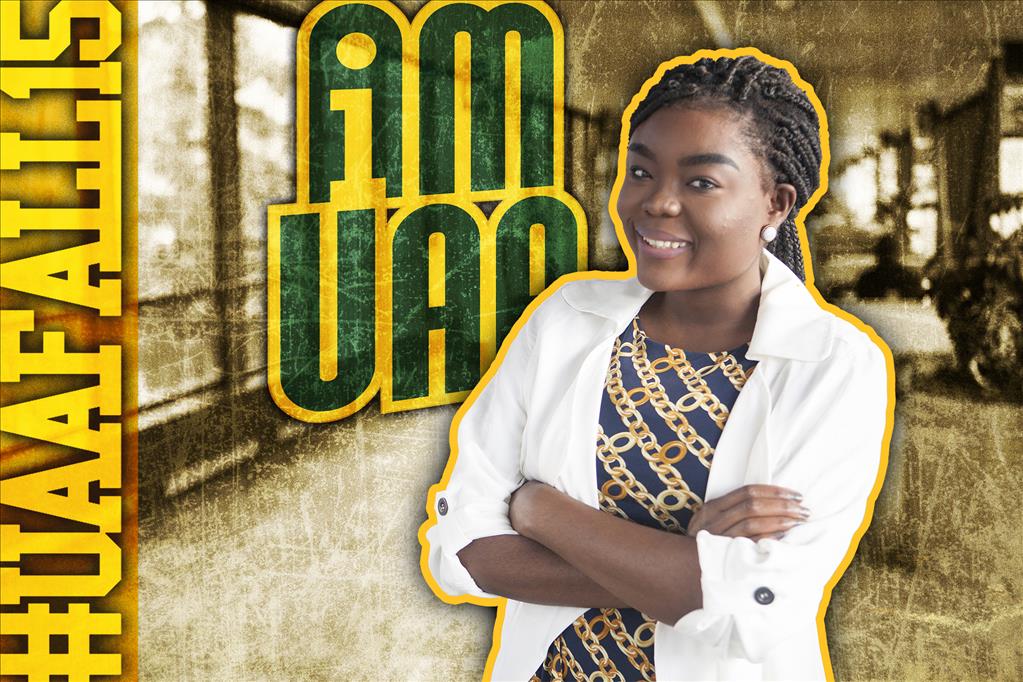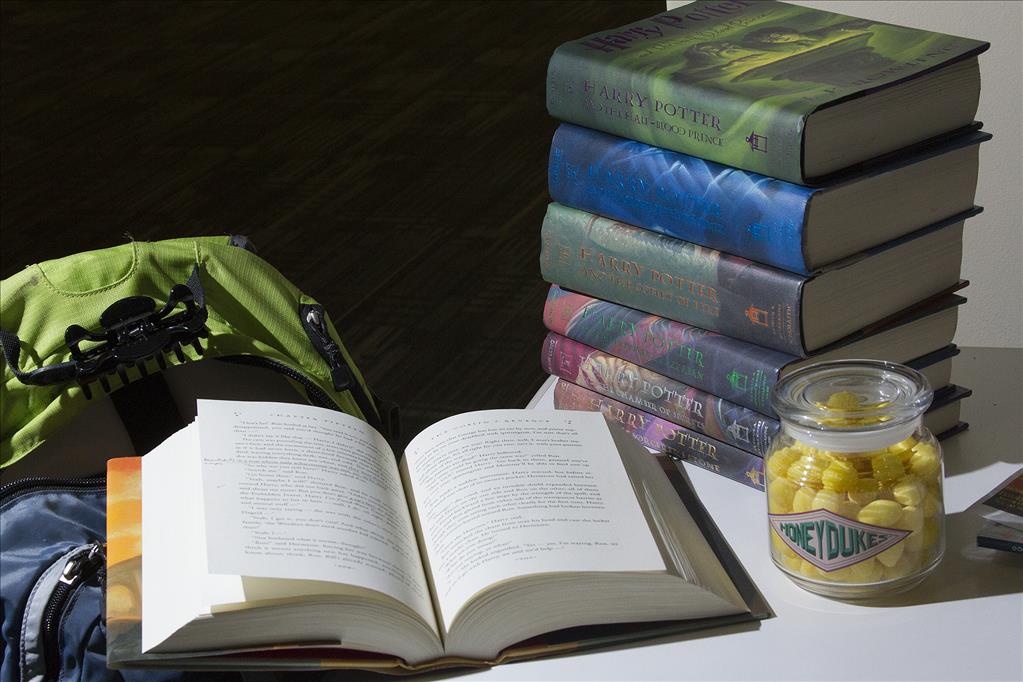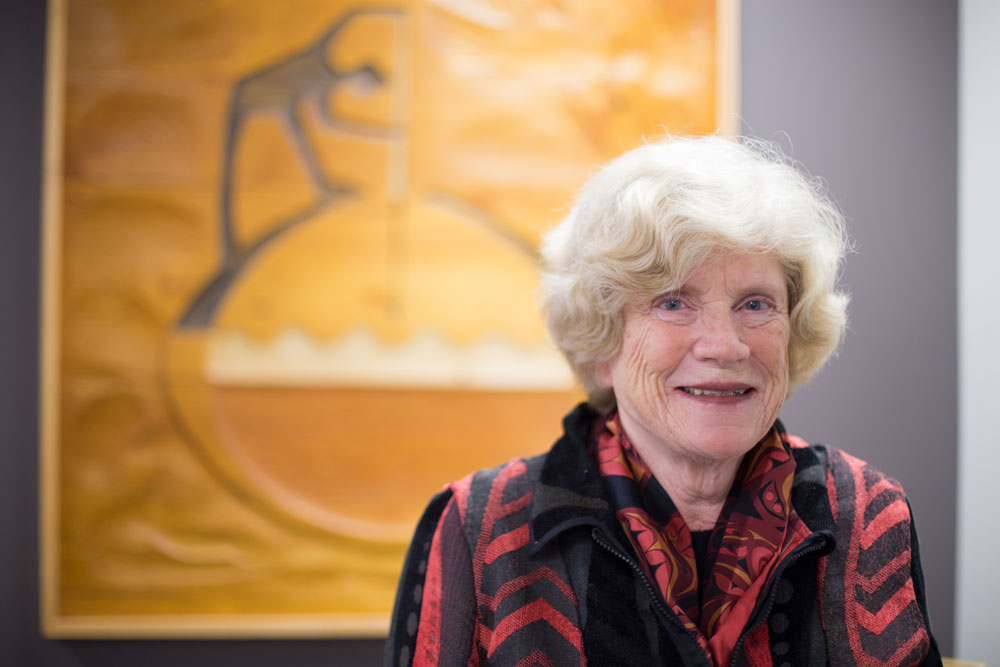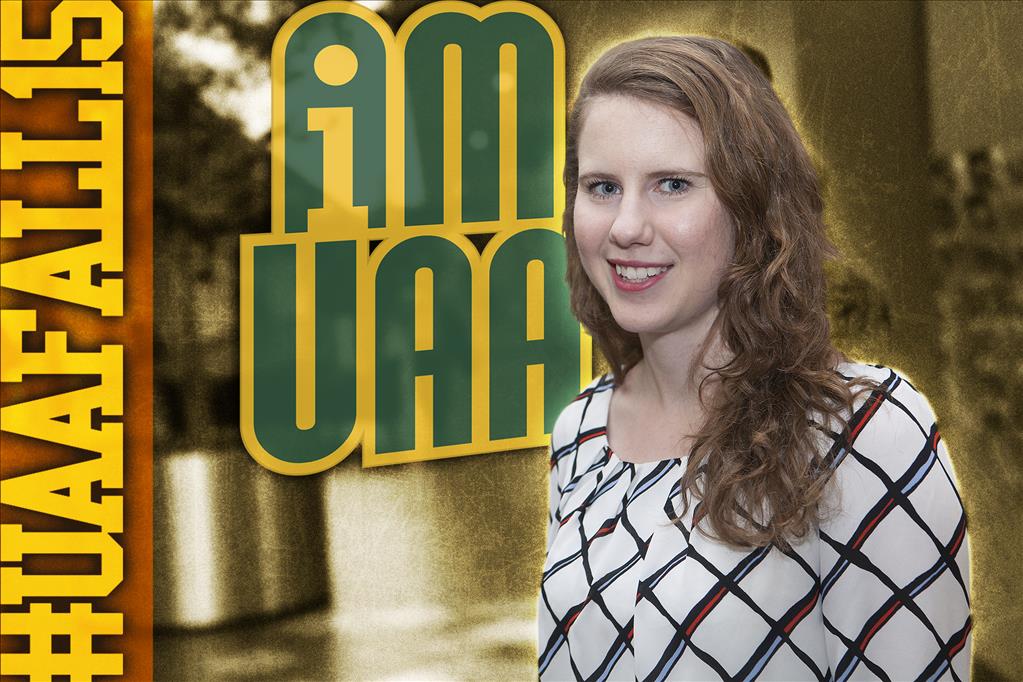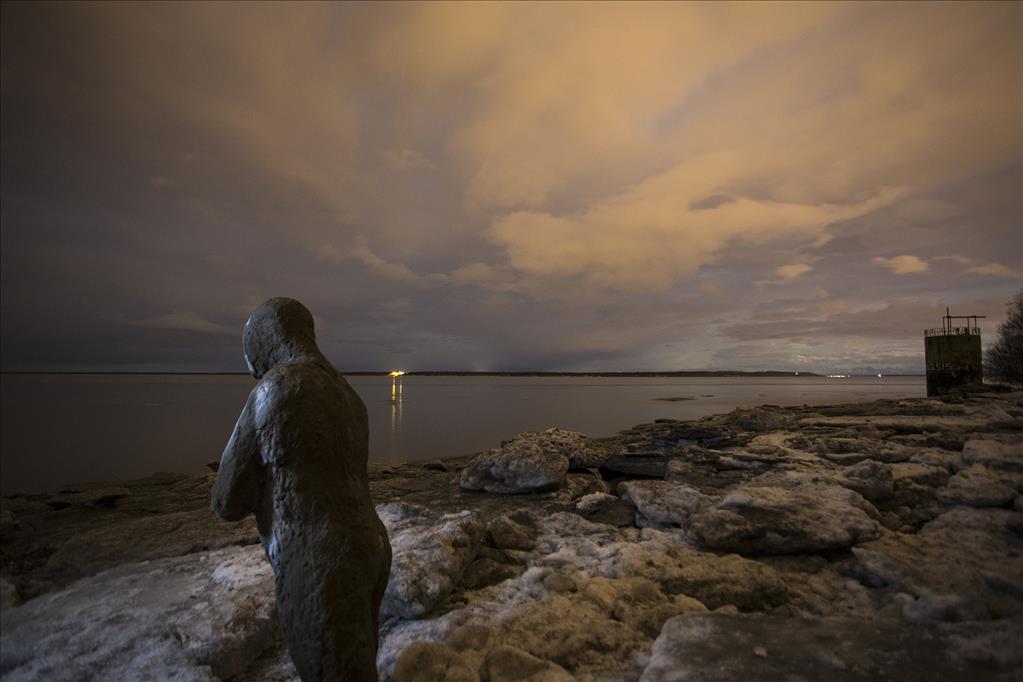Making an EXIT
by J. Besl |
Never heard of the EXIT Art Project? Even if you've discovered the little-known back staircase on the eastern edge of campus, you might not have known the space had a name. But that's about to change.
With the opening reception for Zachariah Martin's latest addition to the student-painted stairwell, EXIT Art has more momentum than ever. Zach's piece-a dark sweeping mural of Alaska Native contemporary culture-is the fourth wall-sized addition to the three-story staircase in the Fine Arts Building.
The idea for a dedicated student art wall was first inspired by-gasp!-UAF. Fine Arts Building manager Cedar Cussins, B.A. '05, started her degree in Fairbanks, and remembers the power of the arts building, where students could write and draw over the walls. "You just felt like you were in a really creative place and when I came into this building [at UAA]... there's a lot of beige," she laughed. "When I became building manager, I really wanted to change that and do something to make the building feel more like the arts building." That opportunity presented itself in the building's back stairwell, located by the first-floor sculpture studios.
"If you think about it, an exit stairwell is kind of space that's forgotten and unused," Cedar said, "but there's an opportunity there. It's not the public face of the university. It's a space where the university can let us explore a little bit more and allow things that aren't tightly controlled, so it seemed like a perfect place to start letting people paint on the walls."
Zach's piece is the third mural in the staircase, but the fourth installment. The graffiti-inspired robot army, painted collaboratively by the Art Students Association, was the first mural completed. The framed portrait at the bottom of the staircase came from a second student collaboration-after a classmate passed away in a car crash, several art students painted her portrait as a gift for the student's family. When the parents asked for the mural to be displayed on campus, it found a home in the growing student art space. The next piece-a crumbling dimension-bending imaginarium by Chris Judd-was the first installment to have its own opening reception. Zach, attending the event, knew he could be next in line.
For Cedar, the opening reception was a step toward cementing the space as a growing student gallery. And it worked. "Out of that reception, Zach came to me with this idea and I just thought... awesome!" she recalled.
The Great Death
Zach wanted to contribute to the EXIT Art Project, but decided to take things one step farther. His piece is the first installed on a ceiling panel, angled at 45 degrees toward the staircase. The unprecedented request spurned an unprecedented response-to reach the ceiling, Zach would need a temporary platform, which required work from Facilities and even a green light from the chancellor's office. He started working on his 8-foot-5-inch-by-8-foot-2-inch panel this summer, often putting in eight-hour days in the back stairwell.
Like other murals in the staircase, Zach's piece forces you to stop and stare at the details. After years of painting on small canvases, Zach found it hard to adjust to broad sweeping brushstrokes. "The more I went on, the more detailed it got and more ideas I got for it," he said.
The overall theme of the piece is fairly controversial, informed by courses in art as well as Alaska Native studies. Zach originally hails from the Upper Tanana region-Tanana Athabascan on his father's side and Ahtna Athabascan on his mother's. During the school years, he would live with family in Anchorage, but return home in summers. As an early art student at UAA, he painted from the Western perspective he'd learned in high school. Certain university classes, though, shifted his focus.
He cites an Alaska history class as the spark for his mural. The professor covered a chapter of Alaska Native history known as first Great Death, which arrived when the first Westerners ushered in diseases and assimilation. The second Great Death occurred last century, with the large push for boarding schools and the gutting influence of alcohol. "It was such a huge blow that it still affects things today," Zach said. His piece-a gloomy battlefield-accepts the aftermath of the Great Death.
But this isn't the Western concept of death. Alaska Native art is traditionally impermanent, a reflection on the culture's circular view of time. Totems and masks serve a momentary purpose, but aren't meant to last. In Western societies, time is linear-there's a beginning, a middle and an end to all things-but not in the Alaska Native social construct. The Great Death is another step in the cycle. In a culture dependent on the seasons, everything is renewed, Zach explained. His piece reflects that on a massive scale.
While many in the community seek to generate fresh interest in old cultures, Zach takes a different approach. "It's killed off already," he reflected. "Instead of trying to bring it back, we should kill it off completely, just let it go, and instead revive it." For him, Alaska Native languages have been broken since the onset of Christianity. "Half the meaning was physical, and half was spiritual. Over half the meaning of our languages is gone," he said.
Rather than focus on the past, Zach's art argues for a new Alaska Native awareness, one that abandons the double identity of two separate cultures. "We should mesh them together to create a new consciousness, a new identity, a new culture. And through that we would still be able to live on," he said.
Eye for details
With a central standoff of blended indigenous warriors, a field of decaying totem poles and a bleeding raven skeleton overpowering the battlefield, Zach's piece certainly catches the eye. Look closely and you'll pick up important details. The circular frame represents the concept of time and renewal. One totem essentially serves as an artist signature, representing key aspects of Zach's life story (a moose for his Athabascan name, a raven and mask for his clan, a marten for... well...for his last name). The diverse army-displaying elements from Africa to Asia to the Aleutians-represents the tug-of-war when races and cultures fuse. The mural's central figure dons a golden mask, a reactionary statement on the traditionally temporary nature of Alaska Native art. While ancestors may have burned their masks after a performance, the warrior's gold mask is made from one of the longest-lasting materials on earth. "It has that feeling of permanence, which is the opposite of our ancestors," Zach noted.
Zach recognizes the bold statement he's making, though his controversial stance doesn't abandon the past. "I want to argue that for revival, it is necessary to kill off something to get something new."
The grand unveiling
After a long summer in a windowless staircase, Zach is now putting the finishing touches on his artwork. In the short term, he's gained some serious arm muscles after painting a ceiling for months. In the long term, he's added his stamp on the UAA campus and solidified the EXIT Art Project.
Zach first approached Cedar after an EXIT Art opening reception, and now it's his turn to inspire the next artist. The campus community is invited to Zach's opening reception on Sept. 11 at 4 p.m.
"The opening reception is a chance to talk to the artist and see the detail they put into their work," Cedar explained. "I think that's going to be a really profound time with Zach's piece. I should probably make him wear a microphone the entire time because there's so much backstory in this piece that it dwarfs anything I've seen before."
All are invited to Zach Martin's opening reception on Friday, Sept. 11, at 4 p.m. in the Fine Arts Building.
Written by J. Besl, UAA Office of University Advancement
 "Making an EXIT" is licensed under a Creative Commons Attribution-NonCommercial 4.0 International License.
"Making an EXIT" is licensed under a Creative Commons Attribution-NonCommercial 4.0 International License.










